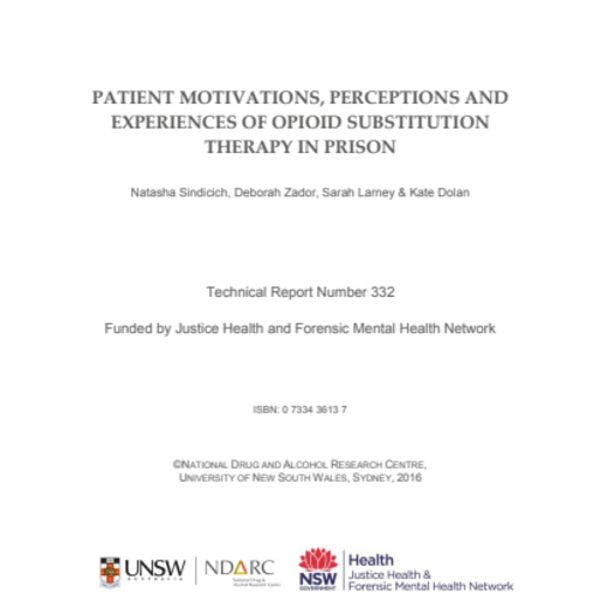Patient motivations, perceptions and experiences of opioid substitution therapy in prison
People with opioid dependence are overrepresented in correctional settings (AIHW, 2013; Indig et al., 2010). Opioid substitution therapy (OST) is an effective treatment for opioid dependence, reducing illicit opioid use (Mattick, Breen, Kimber, & Davoli, 2009, 2014) and mortality (Degenhardt et al., 2011). OST is provided in correctional settings in many jurisdictions around the world (HRI, 2014), but there has been limited examination of the patient experience of opioid substitution therapy (OST) in correctional settings. Unexplored issues include reasons for entering (or not entering) treatment; patient perceptions of advantages and disadvantages of OST in prison; and preferences to cease or remain in treatment on release from prison. This latter issue is of particular importance, as clinicians report that patients often wish to cease OST prior to release, even when informed of the risk of overdose and benefits of remaining in treatment.
This qualitative study aimed to examine patient motivations for, and perceptions and experiences of, OST in prisons in New South Wales (NSW), Australia. Forty-seven participants were recruited from seven correctional centres across NSW between September 2012 and October 2013. All participants had a recorded history of opioid use and/or dependence. To ensure a broad range of perspectives were obtained, participants were selected on the basis of specific exposures to OST:
- Exposure group A (n=7): New inductions to OST. These individuals were within 28 days of commencing OST at the time of interview. They may have been in OST previously, in community or custodial settings;
- Exposure group B (n=11): Continuing OST from the community. This group of patients had been in OST prior to custody, and were in treatment in custody for at least 28 days before interview (i.e. had some familiarity with the opioid treatment program in prison).
- Exposure group C (n=10): Commenced OST in custody. These participants were in treatment for at least 28 days before interview (i.e. had some familiarity with the opioid treatment program in prison).
- Exposure group D (n=9): Voluntarily ceased OST in custody.
- Exposure group E (n=10): Patients who reported heroin use on reception to prison, but have not entered OST or have declined to be placed on the OST waiting list during this custodial sentence.
The sample was predominantly male (n=32; 68%), and 18 participants (38%) identified as Aboriginal and/or Torres Strait Islander. The average age of participants was 35 years. Three-quarters (n=35, 75%) of the sample were sentenced, 11 were on remand, and one participant was unsure of sentencing status. The majority (n=42; 89%) reported a previous incarceration history. Twenty-eight participants were currently prescribed OST (methadone n=27, 57%; buprenorphine-naloxone-naloxone n=1, 2%).
Keep up-to-date with drug policy developments by subscribing to the IDPC Monthly Alert.
